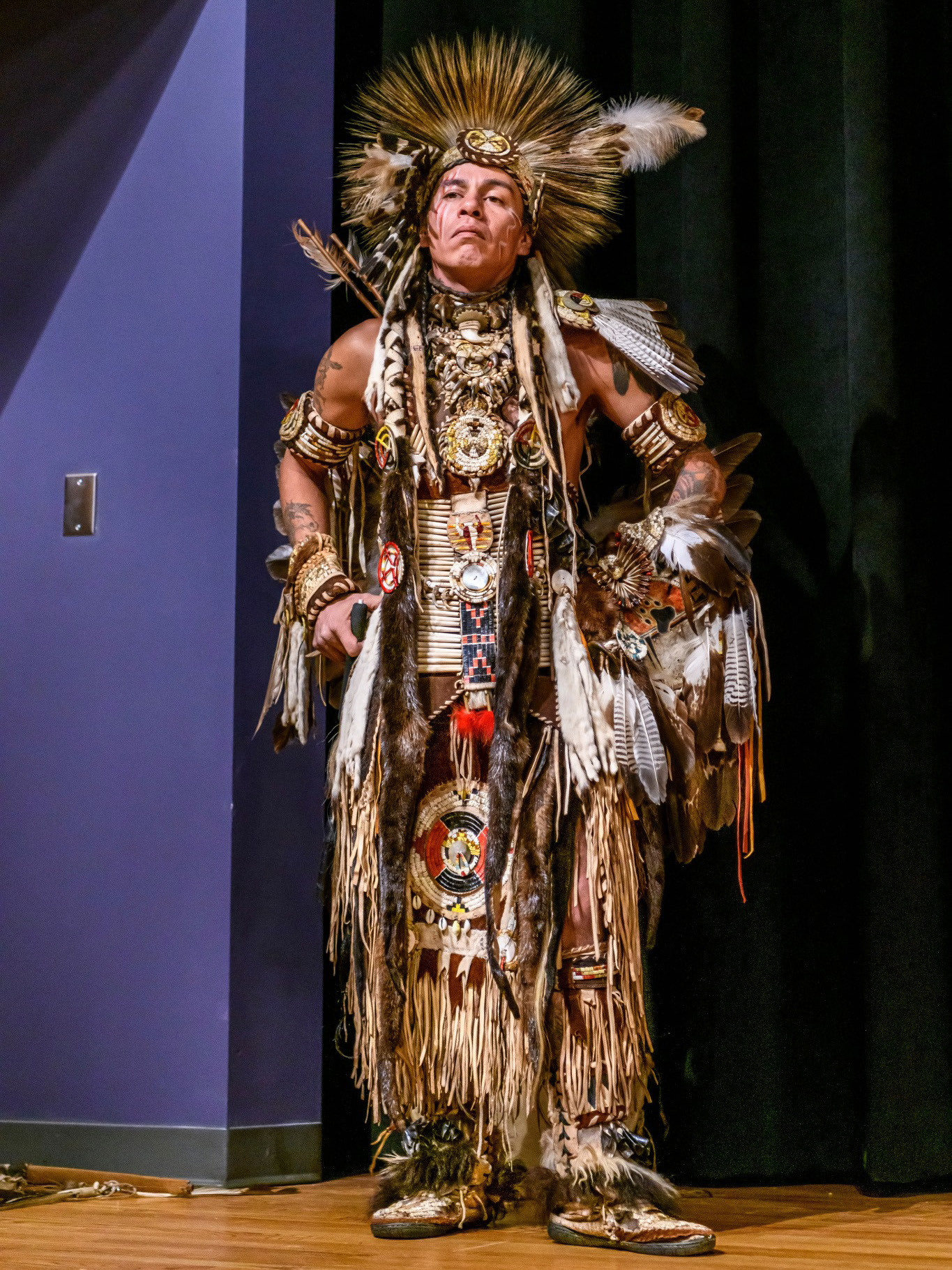The Piscataway Nation Dancers and Singers share the importance of Native American heritage
By: Abigail Nawrot
Sports Editor

“The media doesn’t portray Natives as positive or accurate,” said Mark Tayac, the future 29th Piscataway Nation hereditary tribal chief, during his talk about Native American heritage. “People learn Native American history from cartoons like ‘Pocahontas’, old westerns and sport teams that use our people as mascots.”
Attendees were presented with authentic indigenous heritage by the Piscataway Nation Dancers and Singers on Thursday, Nov. 7.
The performance was organized as part of National American-Indian Heritage Month. It was located in the Bulmer Telecommunications Center Auditorium.
The Piscataway Nation Dancers and Singers introduced themselves with a short musical performance. Tayac then began to describe the significance of the group.
According to Tayac, the Piscataway Nation is an indigenous tribe that is currently located in the state of Maryland.
“At one time our people inhabited Northern Virginia, the entire state of Maryland, and extended into Delaware, Northern New Jersey, across the state of Pennsylvania and all the way right into the Ohio Valley,” Tayac said.
He continued to say that the Piscataway Nation is defined by how far their language, the Eastern Woodland Algoquian Dialect, has reached.
The group’s members included lead narrator and future 29th generation of hereditary tribal chiefs, Mark Tayac, among other members of the tribe, including his nephew Cody and Tayac’s friend.
In the Eastern Woodland Algoquian Dialect, Tayac means chief. Mark Tayac’s father is the present day 28th generation of hereditary chiefs.
“When he passes unto the Spirit World, that title will be passed to me, and when I do, my son will become the 30th generation of hereditary chiefs,” Tayac said.
After introducing the performers, Tayac asked the audience to participate in a group exercise to see how many people have been affected by the media’s portrayal of Native Americans.
Tayac played a beat on his drum and asked audience members to raise their hands if they had heard it.
“More than 70% of you raised your hands,” Tayac said. “To us the drum represents the heartbeat of life, and as long as we keep our drum alive, the beauty of our culture will carry throughout the generations.”
According to Tayac, the drum teaches that no matter what ethnic background, religion or sect of the world a person was born in, the drum represents the heartbeat of life that we all have as a member of the human family.
“We all smile the same way,” Tayac said. “Now, if anyone’s heart sounded like that, I’d tell you to call an ambulance, because they’re having a stroke.”
The audience was then invited on stage to be part of a war dance and a traditional love dance.
Brittney DeLeo, an individual studies major, said she was nervous to be part of the dances.
According to DeLeo, she was invited on stage once the dancers started pulling people from the audience.
“Somehow, they decided I was the brave one,” DeLeo said. “It was definitely fun, but I was really nervous,” she continued. “They gave us no idea what to expect.”
According to Dr. Ernest Rugenstein, a Native American Cultures professor, events like the performance are a great opportunity for educating people about a very marginalized culture that suffered centuries of genocide and oppression.
“The media has really given us this idea that these nice white people were coming through, and the Natives were preventing them from settling, which has really skewed our idea of their culture,” Rugenstein said.
Rugenstein went on to say the performance offered students an invaluable experience to directly learn about the culture from Native Americans.
Tayac explained they were there to celebrate the diversity of Native American culture.
“We’re here today in recognition of November as National American-Indian Heritage Month,” Tayac said. “Here as American-Indians in the US, we represent over 500 different tribes or nations, people with different governments, economics, customs, traditions: but what binds us is our DNA, our Indian blood.”
The Piscataway group has been around for a little over 35 years, beginning by working with Native youth in an effort to teach them traditional songs, customs and teachings, in hope of passing on the American-Indian culture to the next generation.
“We wanted to tell them to be proud for surviving, and to tell them who they were: descendants of great leaders, and for that, they should hold their heads high and be proud of who they are,” Tayac said. “From there we toured all over the US, demonstrating traditional songs and dances,” he continued. “25 years later, we have almost completely traveled the world, sharing our culture.”
After demonstrating a traditional hunting dance, the Piscataway Nation Dancers and Singers invited the audience to take photos with them and approach the group members for questions.
They also displayed a variety of handmade traditional Native American jewelry on the stage, selling them to the attendees. The proceeds went to sponsor their Native youth program.
“Throughout history, we’ve been called derogatory names,” Tayac said. “We are called savages, heathens, renegades and degraded because of our culture,” he continued. “But we are still a strong and beautiful people despite that.”
